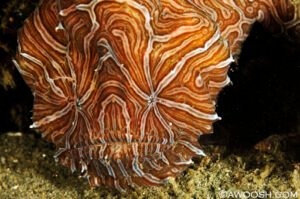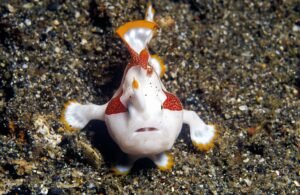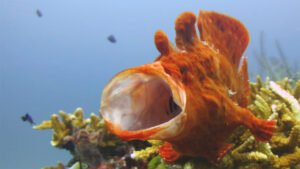Frogfish
Frogfish are fascinating creatures that belong to the family Antennariidae. They are known for their unique appearance and interesting habits. In this blog post, we will explore where frogfish live, what they eat, their habits, and their breeding habits.
Frogfish are primarily found in tropical and subtropical waters around the world. They inhabit coral reefs, rocky areas, and sandy bottoms, blending in perfectly with their surroundings. Their ability to camouflage themselves is truly remarkable, as they can change their color and texture to match the environment they are in. This makes them excellent ambush predators, as they can lie in wait for their prey without being detected.
When it comes to their diet, frogfish are opportunistic feeders. They have a voracious appetite and will eat almost anything that fits in their mouth. Their diet mainly consists of small fish, crustaceans, and even other frogfish. They have a unique feeding technique where they use a modified dorsal fin, called an illicium, to lure their prey close to their mouth. The illicium resembles a fishing lure and can be moved independently to attract unsuspecting prey.
In terms of their habits, frogfish are solitary creatures. They prefer to live alone and only come together during the breeding season. During this time, the male frogfish will attract a female by performing an elaborate courtship dance. Once the female is ready to mate, the male will transfer a packet of sperm, called a spermatophore, to the female. She will then lay her eggs in a gelatinous mass, which the male will fertilize externally.
The eggs are buoyant and will float to the surface, where they will hatch into tiny larvae. These larvae will spend a significant amount of time drifting in the ocean currents, feeding on plankton, before eventually settling on the ocean floor and undergoing metamorphosis into adult frogfish.
In conclusion, frogfish are truly fascinating creatures with their unique appearance and interesting habits. Their ability to blend in with their surroundings, their opportunistic feeding behavior, and their intricate breeding habits make them a subject of great interest for marine biologists and underwater enthusiasts alike. By studying these incredible creatures, we can gain a better understanding of the complex and diverse ecosystems that exist beneath the surface of our oceans.
Where Do Frogfish Live?
Frogfish can be found in warm and tropical waters around the world. They are commonly found in the Indian and Pacific Oceans, as well as the Red Sea and the Caribbean. They prefer to live in coral reefs, rocky areas, and sandy bottoms, where they can camouflage themselves and blend in with their surroundings.
These amazing creatures have the ability to change their color and texture to match their environment, making them almost invisible to predators and prey. They can mimic the appearance of sponges, corals, or even rocks, allowing them to ambush their prey with ease.
The coral reefs provide the perfect habitat for frogfish due to the abundance of food sources and hiding spots. These reefs are teeming with small fish, crustaceans, and other invertebrates that make up the frogfish’s diet. The rocky areas and sandy bottoms also offer ample opportunities for the frogfish to hide and wait for unsuspecting prey to pass by.
In the Indian Ocean, frogfish can be found in popular diving destinations such as the Maldives, Sri Lanka, and the Andaman Islands. These areas are known for their vibrant coral reefs and diverse marine life, making them ideal habitats for frogfish. In the Pacific Ocean, frogfish can be found in places like Indonesia, the Philippines, Thailand and Papua New Guinea. These areas are also known for their rich biodiversity and offer plenty of opportunities for frogfish sightings.
The Red Sea is another hotspot for frogfish, with popular diving destinations like Egypt and Jordan offering excellent chances to spot these fascinating creatures. The Red Sea is home to a wide variety of marine life, including colorful corals and an array of fish species, providing the perfect environment for frogfish to thrive.
The Caribbean is yet another region where frogfish can be found. Countries like Bonaire, Curacao, and the Cayman Islands are known for their crystal-clear waters and stunning coral reefs, making them ideal habitats for these unique fish.
Overall, frogfish can be found in a wide range of warm and tropical waters, but they are most commonly associated with coral reefs, rocky areas, and sandy bottoms. Their incredible ability to blend in with their surroundings allows them to remain hidden from predators and successfully ambush their prey. Whether it’s the Indian and Pacific Oceans, the Red Sea, or the Caribbean, these fascinating creatures can be found in some of the most beautiful and diverse underwater ecosystems on the planet.
Frogfish are not picky eaters and will consume almost anything that comes within their reach. Their diet mainly consists of small fish, crustaceans, and other invertebrates. They have a unique feeding strategy that sets them apart from other predators in the underwater world.
One of the most fascinating aspects of the frogfish’s feeding behavior is its use of a modified dorsal fin called the illicium or “fishing rod.” This specialized appendage extends from the top of the frogfish’s head and acts as a lure to attract prey. At the end of the illicium, there is a fleshy appendage called an esca, which resembles a small fish or worm.
The esca plays a crucial role in the frogfish’s hunting technique. It is designed to mimic the appearance and movement of a potential meal, enticing curious prey to approach for a closer look. As the unsuspecting victim gets closer to investigate, the frogfish seizes the opportunity and swiftly opens its large mouth, creating a powerful suction force that sucks the prey into its jaws.
What makes the frogfish’s feeding strategy even more remarkable is its ability to expand its mouth to more than twice its body size. This incredible flexibility allows the frogfish to swallow prey that is larger than itself. It is not uncommon for these cunning hunters to ambush and consume prey that is nearly their own size.
In addition to their unique feeding strategy, frogfish are also masters of camouflage. They have the remarkable ability to change their color and texture to blend seamlessly with their surroundings. This camouflage helps them remain hidden from both predators and prey, making them highly effective hunters.
Overall, the combination of their specialized illicium, expandable mouth, and exceptional camouflage skills makes frogfish formidable predators in the underwater realm. Their diverse diet and adaptable feeding behavior ensure that they are always well-fed and ready to strike at any opportunity that presents itself. Frogfish are not only fascinating creatures but also exhibit a range of interesting habits. One of their notable habits is their solitary nature. Unlike many other marine species, frogfish prefer to live alone. They are not social animals and do not form groups or colonies. Instead, they find comfort in their own company and establish their territories on the ocean floor.
Another intriguing habit of frogfish is their unique mode of locomotion. While they are not known for their swimming abilities, they have developed an alternative method of movement. Using their pectoral fins, which are located on the sides of their bodies, frogfish can walk across the ocean floor. These fins resemble legs and enable them to move slowly and stealthily, allowing them to approach their prey without alerting them.
In addition to their walking abilities, frogfish possess an extraordinary talent for changing their appearance. They have the remarkable ability to alter their color and texture, which allows them to adapt to different environments and blend in seamlessly with their surroundings. This remarkable skill is not instantaneous; it takes a matter of weeks for them to adjust their appearance. By doing so, frogfish can effectively camouflage themselves and remain undetected by both predators and prey.
Patience is another virtue that frogfish possess. These remarkable creatures can remain motionless for extended periods, patiently waiting for the perfect moment to strike. Their exceptional camouflage, coupled with their ability to remain still, makes them highly efficient predators. They can blend in with the coral reefs or rocky seabed, waiting for unsuspecting prey to come within striking distance. This patient approach ensures their success in capturing their prey while expending minimal energy.
Overall, the habits of frogfish are a testament to their incredible adaptability and survival skills. Their solitary nature, unique walking abilities, color-changing capabilities, and patience all contribute to their success as predators in the marine ecosystem. These habits reflect the remarkable evolution and specialization of frogfish, making them a truly fascinating species to study and appreciate.
Breeding Habits of Frogfish
Frogfish have unique breeding habits that vary among different species. In general, female frogfish produce thousands of eggs, which are released into the water. The male frogfish then fertilizes the eggs externally. This method of reproduction, known as external fertilization, is common among many aquatic species and allows for the dispersal of a large number of offspring.
Once fertilized, the eggs develop into floating masses or gelatinous blobs, which provide protection for the developing embryos. The color and texture of these egg masses often resemble the surroundings, further enhancing their chances of survival. This camouflage adaptation helps to conceal the eggs from potential predators, increasing the likelihood of successful hatching.
After a period of time, the eggs hatch, and the tiny frogfish larvae emerge. These larvae are completely different in appearance from the adults and are equipped with a small, fan-like structure called a velum, which helps them swim and feed on plankton. The velum acts as a propulsion system, allowing the larvae to move through the water and capture their microscopic prey.
As the larvae grow, they undergo metamorphosis and gradually develop the characteristic features of adult frogfish. This process can take several weeks or even months, depending on the species. During this time, the larvae undergo significant changes in their body shape, coloration, and behavior, preparing them for life as fully functional adult frogfish.
It is worth noting that frogfish have relatively short lifespans, typically ranging from one to three years. However, during their short lives, they play a crucial role in maintaining the balance of marine ecosystems by controlling the population of small fish and invertebrates. Their unique hunting techniques and ability to blend into their surroundings make them highly efficient predators, ensuring the health and stability of their habitats.
